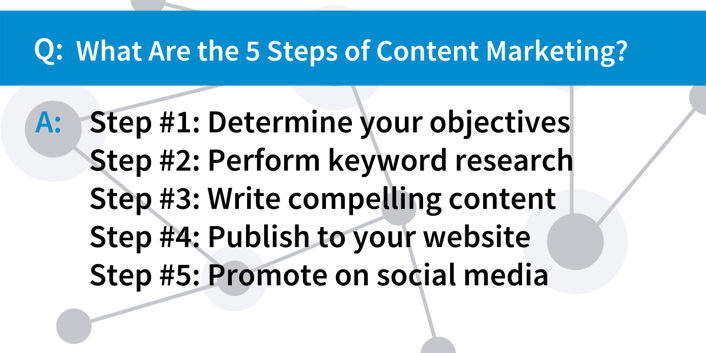What Are the 5 Steps of Content Marketing?
August 2, 2022 •Josh Daugherty

Whether you’re new to content marketing or you’re experienced but looking for a new strategy, there is both good and bad news in the fact that there are relatively unlimited content marketing strategy examples easily accessible online. Whether these come in the form of instructive articles or a content marketing course, many of these will tease transformative outcomes. The problem is, they mostly keep their promises vague while describing similarly vague processes for achieving those results.
In this blog, we’ll be exploring how to create a content strategy —specifically, how to write content that actually engages readers and drives business outcomes. So, what are the steps to developing a content marketing strategy that works? We believe in a 5-step process:

Step #1: Determine Your Objectives
Throwing content at the wall to see what sticks isn’t a very sophisticated—or successful—strategy, so setting specific goals is an essential first step. In order to inform strategy, these should be SMART objectives: specific, measurable, achievable, relevant, and timely.
In other words, your objective (or objectives) simply answers the question, “What do we want to accomplish?” Appropriate objectives for content marketing might include things like:
- Attracting 300 new subscribers or improving retention rates among existing subscribers by 15% over the next quarter.
- Getting 75 prospects to sign up for a demo, register for an event, or download a digital resource.
- Improving lead conversion rates by 20% over the next quarter.
Step #2: Perform Keyword Research
Once you know what you’re trying to achieve with your content marketing initiative, you can begin developing strategies. The overarching goal of content marketing is to connect with potential customers by anticipating their needs and publishing content that gives them exactly what they’re looking for. How do you know what kind of content to create, though? With DemandJump, of course!
DemandJump is the world’s first Pillar-Based Marketing (PBM) platform. Why does that matter? Because it’s a proven tactic for improving where your company appears in online search results when prospective customers are looking for the products or services you provide. In a nutshell, the concept behind PBM is simple: provide value to customers through informative, no-strings-attached content.
This is one of the most important, if not the most important, of all the content marketing strategy process steps. Within the DemandJump platform, you can perform intensive keyword research with a few simple clicks. Not only can you see the topics and questions customers are searching for (in the exact words they’re using to search for them), but you can also see where you currently stand in relation to your competitors. This way, you can be strategic in developing content that will help your customers and your company!
Want to see what this looks like? No problem! You can create a free account today to run Insight Reports, generate Content Briefs, and much more.
Step #3: Write Compelling Content
Once you’ve identified the keywords and questions you want to improve your ranking for, you can start developing content. Remember, the point is not to write pure marketing content—quite the opposite, actually. While you’ll obviously be mentioning your company and what you offer, it shouldn’t be the main focus of the content. Rather, you want to answer the questions they’re asking. And if you can do that without being overly salesy, you build credibility with readers.

What Kind(s) of Content Should I Write?
In terms of the types of content to create, Pillar-Based Marketing content should prioritize informative, easy-to-understand articles. Additionally, here’s what generally makes up an effective content marketing framework:
- One pillar page of around 3,000 words. This piece of content serves as a broad, comprehensive resource on a topic. For example, here’s DemandJump’s content marketing pillar page. Within a pillar page, you should include around 20 high-ranking keywords.
- Three sub-pillar pages of around 2,000 words. Each of these pieces should offer readers a more in-depth look at one particular component of the overall pillar strategy, and include around 15 keywords.
- A network of around a dozen shorter, topic-specific supporting blogs of at least 750 words each. What you’re reading right now is a prime example of a blog that (we hope) effectively answers the question, “What are the 5 steps of content marketing?”
How Can You Ensure Your Content Drives Action?
Considering the sheer amount of words you’ll be writing, you’ll want to do everything you can to ensure that it will actually drive action—in other words, succeed. Here are a few tips for developing actionable content that can help generate leads for your business:
- Make the content easy to read. This means what you write should be unique and interesting, relevant to what they’re searching for (and what you provide), and appropriate in terms of tone and complexity. In business writing, it’s generally best to write at around an 8th grade level.
- Focus on value, first and foremost. The point of content marketing is to attract and engage potential customers before the sales team receives them as leads. Content marketers are wise to leave the sales talk to the sales team, and not be too pushy with the value propositions.
- Include a call to action. When including a call to action (CTA) at the end of any content piece, make sure it’s clear exactly what readers should do next. This is where you can connect the dots between your content pieces and the content marketing objectives you came up with in Step #1.
If you’re unsure how to go about actually writing your content, DemandJump also offers content writing services. Contact us to learn more!
Step #4: Publish on Your Website
Once you’ve written your content, you’re ready to publish! While there isn’t necessarily a hard-and-fast rule about how to publish content, we generally recommend either publishing it all at once, or publishing the bigger pieces first (pillar, sub-pillars), and then the blogs later. Without getting too into the weeds around search algorithms and authority, these types of tactics essentially signal to Google and other search engines that your company’s website is a credible authority on the topic.
It’s also important to strategically link your content pieces together. For Pillar-Based Marketing, we generally recommend:
- Including links to the relevant pillar and sub-pillar page within each blog
- Including a link to the pillar page within each sub-pillar
Interconnecting your pieces of content in this way helps further demonstrate your credibility and authority to search engines, helping your pages rank higher, quicker.
Step #5: Promote via Social Media
At this point, you should have just made a massive impact on your website by publishing literally thousands of words on topics related to your business. It’s not quite time to sit back and consider the content marketing process complete, though.
By writing content that relates directly to your keyword research, the step of publishing should provide some immediate gains in terms of where you appear in search rankings when people are searching for specific information. There’s more you can do, though, to more actively get your content in front of the right people at the right time. In other words, you need to promote your content via social media.
How Can You Make Sure Your Content Is Seen?
The best way to ensure that your content gets in front of your potential customers is through social media promotion. For each piece of content (pillar, sub-pillar, or blog), you should try to promote it on at least a couple social media channels. Depending on your target audience and their preferences, you might consider posting on Twitter, Facebook, LinkedIn, Instagram, or any other social platform you know your customers are using.
Write the Right Content with DemandJump
The DemandJump platform offers a powerful set of tools to empower content marketers at each step of the process described in this blog. And we’ve just barely scratched the surface of everything it can do!
Click the button below to create your free account and get started today.
Featured Articles
Categories
- Attribution Tracking (13)
- Channel Optimization (11)
- Consumer Insights (68)
- Content Marketing (251)
- Data Science (8)
- Digital Marketing (6)
- Digital Transformation (26)
- Enterprise (10)
- Lead Generation (14)
- Market Intelligence (8)
- Marketing Analytics (39)
- Marketing Attribution (57)
- Marketing Management (153)
- Marketing Operations (86)
- Organic Search (222)
- Paid Search (52)
- Pillar-Based Marketing (63)
- Programmatic Advertising (9)
- SaaS Content (14)
- SaaS Marketing (29)
- Search Marketing (111)
- SEO Keyword Research (28)
- SEO Pillar (18)
- SEO Strategy (46)
- SMB (5)
- Website Content (12)


